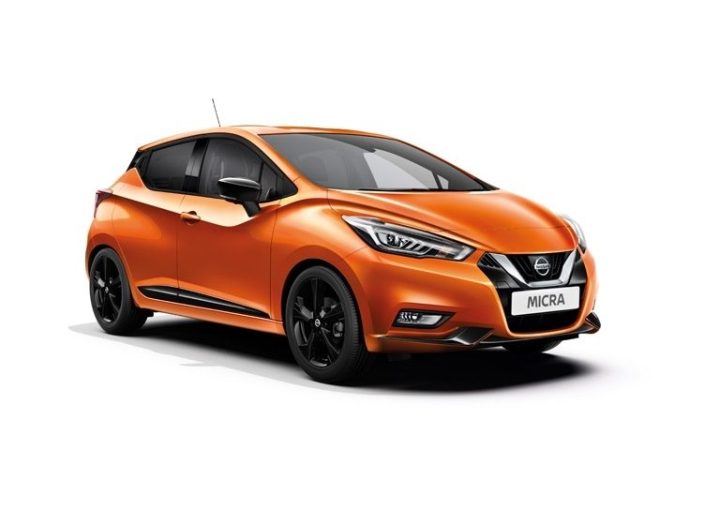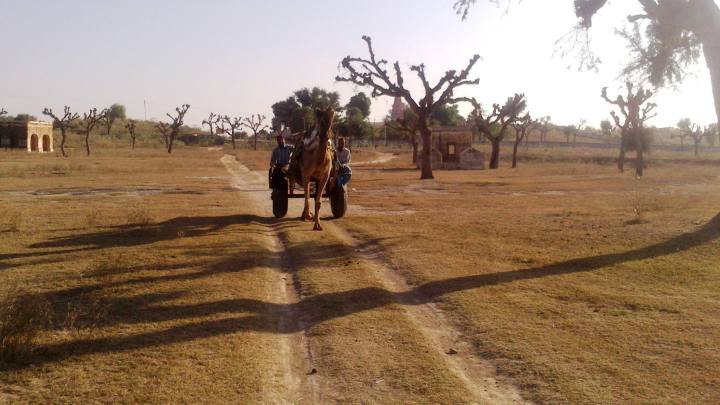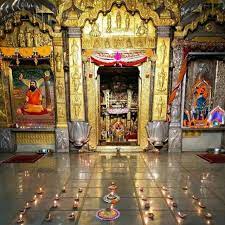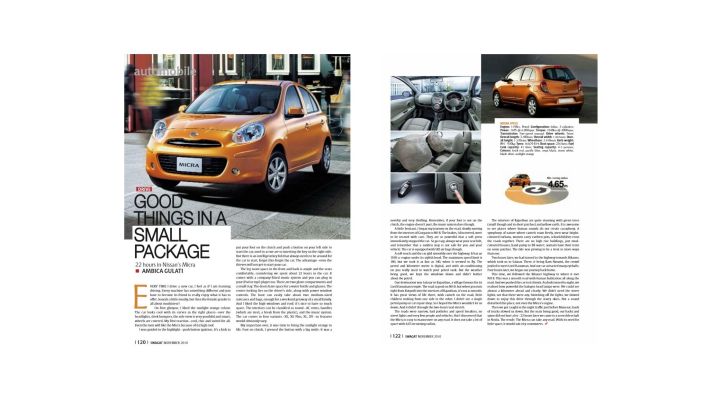I was invited to drive Nissan’s Micra in 2010 when it had entered the Indian market. We tested its strength on a 22-hour long journey from Delhi to Salasar and back
(According to autocarindia.com, Micra was available in India till 2020 and then discontinued due to slow sales and the market transition into the BS6 era. Micar now has a facelift and will be on sale in Mexico. It is now called Nissan Micra.)
Our destination was Salasar in Rajasthan, a village in Churu district on NH 66, famous for its Lord Balaji Hanuman temple. From Delhi, we needed to take NH 8, which is the highway to Gurugram going towards Jaipur. And from there, we needed to turn on the highway to Bikaner. But somewhere the GPS took us inside the rural belt. We turned from Kotputli into the interiors of Rajasthan, and it wasn’t smooth. It had great views of life there, with camels on the road, little children rushing from one side to the other. There wasn’t a single petrol pump or car repair shop. So I hoped the Micra wouldn’t let us down. And it didn’t.
Testing the Micra

Every time I drive a new car, I feel as if I am learning driving. Every machine has something different and you have to become its friend to really enjoy what it has to offer. Sounds a little mushy, but then the female gender is all about mushiness! On first glimpse, I liked the sunlight orange colour. The car looked cool with its curves in the right places—over the headlights, sleek bumpers.
I was guided to the highlight—push button ignition. It was a kick to put your foot on the clutch and push a button on your left side to start the car, as we are used to inserting the key on the right side. But there was an intelligent key fob that always needed to be around for the car to start. Forget this, forget the car. The advantage—even the thieves couldn’t start the car.
The leg room space in the front and back was ample and the seats comfortable, considering we spent about 22 hours in the car. It came with a company-fitted music system and you could plug in your iPod or mp3 player too. There were two glove compartments and a small tray. The doors had space for a water bottle and glasses. The centre-locking lay on the driver’s side, along with power window controls. The boot could easily take about two medium-sized suitcases and bags, enough for a weekend getaway of a small family.
And I liked the high windows and roof; it was nice to have so much space. The interiors could be classified as round—AC vents, handles (which were steel, a break from the plastic), and the music system. The car came in four variants—XE, XE Plus, XL, XV—so features varied. My inspection over, it was time to bring the sunlight orange to life. Foot on clutch, I pressed the button with a big smile. It was a novelty and very thrilling. If the foot was not on the clutch, the engine didn’t purr, the music system did though.
On The Road
A little hesitant, I slowly moved from the interiors of Gurugram to NH 8. The brakes, I discovered, were to be treated with care, so powerful that a soft press immediately stopped the car. The car was equipped with SRS air bags. It had an 1198 cc engine under its stylish hood. The maximum speed limit was 180, but we took it as fast as 140, when it seemed to fly. The petrol and km metre was digital, and with air-conditioning on, you needed to watch the petrol tank. But the weather being good, we kept the windows down and didn’t bother about the petrol.
As we turned into the interiors of Rajasthan, the roads were narrow, had potholes and speed breakers, no street lights and very few people and vehicles. But the Micra was easy to manoeuvre on any road. It did not take a lot of space with 4.65 m turning radius.

Despite the bad road, the interiors of Rajasthan were stunning with green trees (small though and in short patches) and yellow earth. It was awesome to see places where human sounds do not create cacophony. A symphony of nature where camels roamed freely, men wore bright turbans, women carried earthen pots, and schoolchildren crossed the roads together. There were no high rise buildings, just mud-colored houses, hand pumps to fill water; nomads had their tents on some patches. The ride proved to be a treat in more ways than one.
Balaji Temple
Two hours later, we had turned to the highway towards Bikaner, which took us to Salasar. There, it being Ram Navami, the crowd jostled to meet Lord Hanuman. And our car attracted many eyeballs.

The temple is the heart of the town. The fame of this temple lies in a folk lore. Way back in time, a farmer was ploughing his land in the village of Asota. He hit an object and further digging revealed stones. And more digging revealed an idol of Hanuman. The day was Saturday, auspicious Navami (9th day) of Shravan month (July-August) in the bright half (first fortnight) of the month. The farmer told the village about this idol. And apparently, the landlord also had a dream that day in which Lord Hanuman had asked him to make a temple in Salasar. In a series of coincident dreams, another resident, Mohandas, also saw Lord Hanuman telling him to install the idol.
The USP of this temple is that the idol has a moustache and a beard. The locals say that the god blessed the land with water and the wells always had water. People come from far to take his blessings through their difficult times. Prayers here also help get rid of ghostly and ghastly issues. Devotees tie a coconut around the sacred tree within the complex, with the belief that all their problems will be taken care of. And this coconut is left tied till the problem is resolved.
The drive home
Four hours later, we began our journey back home. This time, the GPS didn’t betray us and we found our way along the Bikaner highway to where it met NH 8. This was a smooth road with human habitation all along the road. And we pushed the car to its limits. As dusk turned to night, we realised how powerful the halogen head lamps were. We could see almost a kilometre ahead and clearly. We didn’t need the street lights, not that there were any. Switching off the lights, we slowed down to enjoy this drive through the starry skies. Not a sound disturbed this place, not even the Micra’s engine.
Then we got caught in the night traffic just before Manesar, loads of trucks slowed us down. But the seats being good, our backs and spine did not hurt a lot—22 hours later we came to a screechless halt in Noida.
Reach Salasar by train: There is a train till Sikar and then you can take a private vehicle or public transport to Salasar. Do try the Rajasthani thali outside the temple, as the temple is the only attraction of this small town.

This article first appeared in Swagat, Air India’s inflight magazine, November 2010 issue.


Salasar temple has a huge following in this region. I love the looks of the car.
LikeLiked by 1 person
Yeah. I believe it has grown tremendously. It had lots of energy. The car was good for the city. But didn’t make it big in the Indian market
LikeLiked by 1 person
yeah
LikeLiked by 1 person
I have never been to Salasar. Such road trips need a proper vehicle and it seems you ave enjoyed your trip in Micra.
LikeLike
It’s a small pilgrim town.
LikeLike
I have been to Salasar from Jaipur when my son was born. Such a trip needs a good vehicle and seems that Micra proved that.
LikeLiked by 1 person
Yes, Salasar is a famous pilgrimage in Rajasthan, glad to know you have visited it too.
LikeLike
I had never been to Salasar but visited few other cities in Rajasthan and had a great time. loved reading your micra driving experience. it seems you had a great time while doing that.
LikeLiked by 1 person
I wish to explore Salsar after reading your post but in my own small i10 car. So far it served us well for our trip to ludhiana, Agra and Khajuraho without any complain.
LikeLike
Oh yes, you take the highway to Bikaner and it’s a smooth ride in any car, Have a good trip.
LikeLike
The drive from Delhi to Salasar sounds really interesting. It gave you a wonderful opportunity to feel the vibes of the interiors of Rajasthan. The Micra seems to have measured up to the rigours of the road well.
LikeLiked by 1 person
The drive sounds really interesting. I stay near delhi and would love to visit this place someday. Thank you for sharing about this place and your drive experience.
LikeLiked by 1 person
The micra definitely gave you a comfortable journey experience for a whopping 22 hours. The temple seems to be a heritage historic symbol. Will try to visit
LikeLiked by 1 person
Great car review and travel blog! Truly an experience that deserves a blog post! First time hearing about this brand. Glad the travel turned out well for you!
LikeLiked by 1 person
I have never been to Salasar. Road trips are always fun but with a good vehicle ofcourse. Nissan Micra is a nice car .
LikeLiked by 1 person
Road trips are best enjoyed at a slow pace. They are fun!
LikeLiked by 1 person
Reblogged this on Holistic Wellness with RJ and commented:
The blog gives me more motivation to travel again
LikeLiked by 1 person
That’s awesome! Thanks.
LikeLiked by 1 person
Your posts are giving me the push to start travelling again. Since the pandemic broke out my travelling has become near to nothing. Got to resume soon.
LikeLiked by 1 person
All the best for your trips.
LikeLiked by 1 person
Great article
well written
Visit https://www.travliv360.com/the-ultimate-offbeat-things-to-do-in-delhi/ for more amazing info
LikeLiked by 2 people
Thank you
LikeLiked by 1 person
Driving from Delhi to Salasar Balaji in a Micra is a comfortable journey, perfect for a pilgrimage to the revered Salasar Balaji temple. For convenience, consider checking Salasar Balaji online booking options in advance to ensure a seamless visit to this sacred destination.
LikeLike